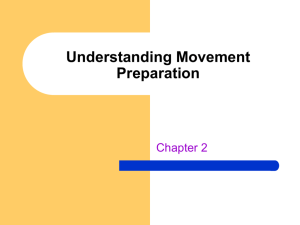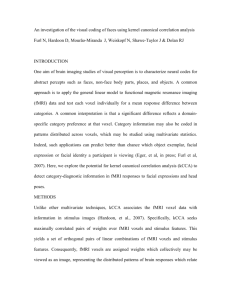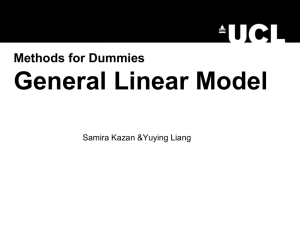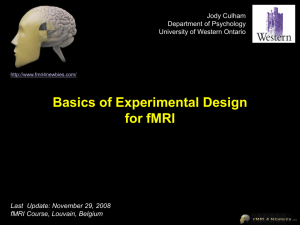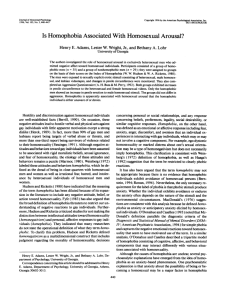Electronic Supplementary Material
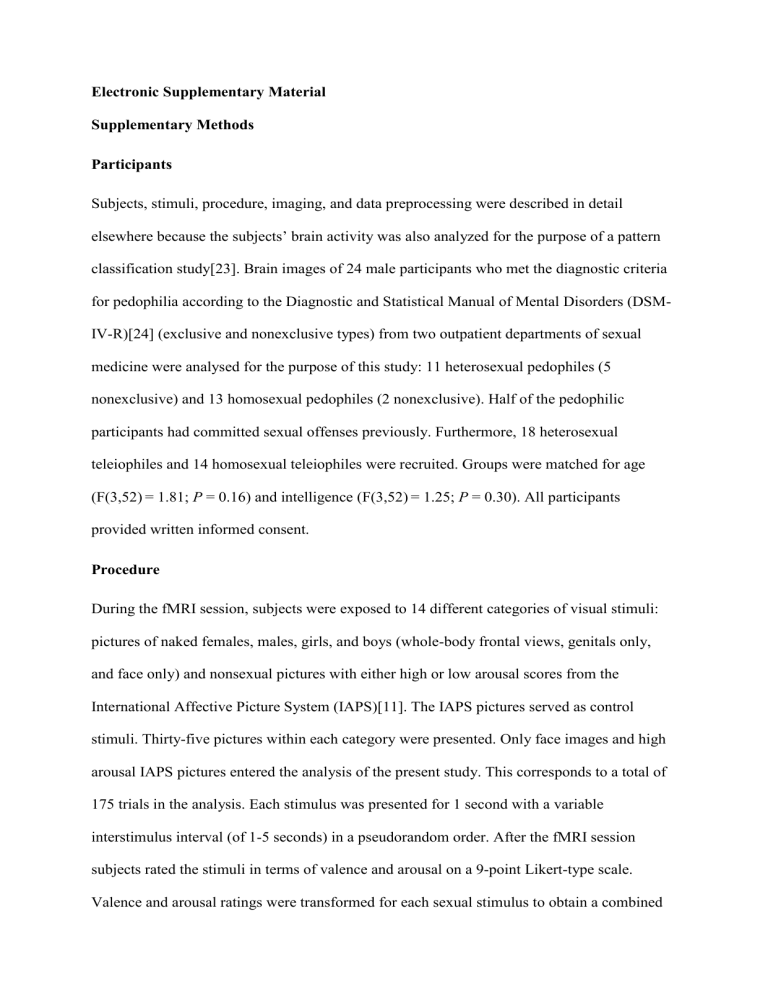
Electronic Supplementary Material
Supplementary Methods
Participants
Subjects, stimuli, procedure, imaging, and data preprocessing were described in detail elsewhere because the subjects’ brain activity was also analyzed for the purpose of a pattern classification study[23]. Brain images of 24 male participants who met the diagnostic criteria for pedophilia according to the Diagnostic and Statistical Manual of Mental Disorders (DSM-
IV-R)[24] (exclusive and nonexclusive types) from two outpatient departments of sexual medicine were analysed for the purpose of this study: 11 heterosexual pedophiles (5 nonexclusive) and 13 homosexual pedophiles (2 nonexclusive). Half of the pedophilic participants had committed sexual offenses previously. Furthermore, 18 heterosexual teleiophiles and 14 homosexual teleiophiles were recruited. Groups were matched for age
(F(3,52) = 1.81; P = 0.16) and intelligence (F(3,52) = 1.25; P = 0.30). All participants provided written informed consent.
Procedure
During the fMRI session, subjects were exposed to 14 different categories of visual stimuli: pictures of naked females, males, girls, and boys (whole-body frontal views, genitals only, and face only) and nonsexual pictures with either high or low arousal scores from the
International Affective Picture System (IAPS)[11]. The IAPS pictures served as control stimuli. Thirty-five pictures within each category were presented. Only face images and high arousal IAPS pictures entered the analysis of the present study. This corresponds to a total of
175 trials in the analysis. Each stimulus was presented for 1 second with a variable interstimulus interval (of 1-5 seconds) in a pseudorandom order. After the fMRI session subjects rated the stimuli in terms of valence and arousal on a 9-point Likert-type scale.
Valence and arousal ratings were transformed for each sexual stimulus to obtain a combined
index (valence x arousal / 9) that we found to be closely correlated with sexual attractiveness ratings[25].
Functional magnetic resonance imaging data acquisition
MRI scanning was performed on a 3-T whole-body MRI scanner (Achieva; Philips, Best, the
Netherlands). A 3-dimensional spoiled gradient echo acquisition with sagittal volume excitation (1 X 1 X 1 mm voxels) acquired a structural T1 volume for each participant, followed by three fMRI runs. In each fMRI run, 352 volumes were acquired. Functional MRI measurements of the BOLD signal were performed using an echo planar imaging (EPI) sequence (TR = 2500 ms; TE = 36.8 ms; flip angle: 90°). The field of view covered the whole brain (38 axial slices, 3 mm slice thickness with 0.3 mm interslice gap). Axial slices were acquired parallel to the anterior-posterior commissural plane.
Functional magnetic resonance imaging preprocessing
Data preprocessing and statistical analysis were performed with SPM8 software
(http://www.fil.ion.ucl.ac.uk/spm/). Realigned and normalized EPI images were coregistered to individual T1-weighted images and normalized using a complex nonlinear spatial normalization function determined with the SPM segment procedure. The normalized images were spatially smoothed (FWHM 8 mm).
For individual subject analysis (first level), a general linear model for fMRI time series was specified using separate regressors for each stimulus condition (boy’s face, man’s face, girl’s face, woman’s face, and high-arousal nonsexual picture) and six regressors with movement parameters as estimated in the realignment step. Stimulus-related responses were convolved with the standard hemodynamic response function. Regression coefficients (parameter estimates) for all regressors were estimated within a subject-specific, fixed-effects model[26].
Low-frequency drifts in the BOLD signal were removed by a high-pass filter with a cutoff of
128 s. Contrast images of interest were selected for each participant, including BOLD signal increases associated with each stimulus type.
For group analysis (second level), we built a (three-way) flexible factorial design with the parameter estimates of each stimulus condition (n = 13) for each subject as a stimulus factor.
The remaining two factors within this design were group (four levels) and subject (56 levels).
The subject factor was aimed to capture any further subject-related variance not modeled by any of the other factors (e. g., handedness). We then calculated statistical maps ( t contrasts) of the sexually preferred age and gender group relative to the nonpreferred age group of the preferred gender (i. e., women’s vs. girls’ faces for heterosexual men, men’s vs. boys’ faces for homosexual men, girl’s vs. women’s faces for heterosexual pedophiles, and boys’ vs. men’s faces for homosexual pedophiles) to estimate effects of sexual age preference across all groups independent of the gender of the stimulus and the participants’ sexual orientation.
Furthermore, to quantify regional differences in the age-related BOLD response, we calculated t contrasts between groups. To test for consistent effects in all groups, we calculated the (age-) preference-specific brain effects of each group separately and submitted the resulting t-maps to a conjunction analysis using the conjunction null option of the SPM software with a threshold of P < 0.01.



